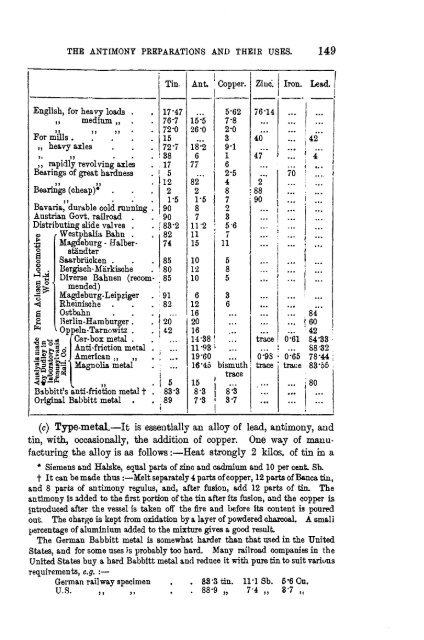antimony - Sciencemadness.org
antimony - Sciencemadness.org
antimony - Sciencemadness.org
You also want an ePaper? Increase the reach of your titles
YUMPU automatically turns print PDFs into web optimized ePapers that Google loves.
Achs<br />
Fro]<br />
THE ANTIMONY PREPARATIONS AND THEIR USES.<br />
Tin.<br />
Ant<br />
English, for heavy loads .<br />
,, medium,,<br />
For mills .<br />
,, heavy axles<br />
> J><br />
„ rapidly revolving axles<br />
Bearings of great hardness<br />
} > a<br />
Bearings (cheap)*<br />
Bavaria, durable cold running .<br />
Austrian Govt. railroad .<br />
Distributing slide valves .<br />
© r Westphalia, Bahn .<br />
*•£ Magdeburg - Halber-<br />
0g0 standter<br />
Saarbriicken .<br />
Bergisch-Markische<br />
Diverse Bahnen (recommended)<br />
Magdeburg-Leipziger<br />
Rheinische .<br />
S Ostbahn<br />
1-Jerlin-Hamburger •<br />
>• Oppeln-Tarnowitz<br />
17*47<br />
76*7<br />
72*0<br />
15<br />
72*7<br />
38<br />
175<br />
12<br />
21*5<br />
90<br />
90<br />
83-2<br />
82<br />
74<br />
85<br />
80<br />
85<br />
91<br />
82<br />
42<br />
15<br />
,§ C«M ea [ Car-box metal<br />
a '£, ^1 d Anti-friction metal .<br />
«*33^J American ., ,,<br />
&g 2 IN I Magnolia metal ; -<br />
!*-* 1<br />
5<br />
Babbitt's anti-Mction metal f . 83*3<br />
Original Babbitt metal ;89<br />
I<br />
: 5<br />
26*0<br />
18*2<br />
6<br />
77<br />
82"<br />
21*5<br />
8<br />
7<br />
11-2<br />
11<br />
15<br />
10<br />
12<br />
10<br />
6<br />
16 12<br />
20<br />
16<br />
14-38<br />
11-93<br />
19'60<br />
16-45<br />
15<br />
8-3<br />
7'3<br />
Copper.<br />
5-62<br />
7*8<br />
2-0<br />
3<br />
9-1<br />
1<br />
6<br />
2*5<br />
4<br />
8<br />
2<br />
3<br />
5'6<br />
7<br />
11<br />
5 8<br />
5<br />
3 6<br />
...<br />
bismuth<br />
trace<br />
8 : 3<br />
3-7<br />
Zinc.<br />
7614<br />
46"<br />
47*"<br />
...<br />
2<br />
88<br />
90<br />
...<br />
...<br />
...<br />
trace<br />
0 V 9S<br />
trace<br />
...<br />
149<br />
Iron. Lead*<br />
... ...<br />
... 42*<br />
4<br />
70 I ;;;.<br />
... . ...<br />
...<br />
...<br />
...<br />
...<br />
'.'.'. 84"<br />
... ! 60<br />
... ! 42 !<br />
0-61 84*33<br />
... S832<br />
0-65 78*44 :<br />
trace 83*55<br />
... 80<br />
...<br />
(c) Type-metal.—It is essentially an alloy of lead, <strong>antimony</strong>, and<br />
tin, with, occasionally, the addition of copper. One way of manufacturing<br />
the alloy is as follows:—Heat strongly 2 kilos, of tin in a<br />
* Siemens and Halske, equal parts of zinc and cadmium and 10 per cent. Sb.<br />
f It can be made thus :—Melt separately 4 parts of copper, 12 parts of Banca tin,<br />
and 8 parts of <strong>antimony</strong> regulus, and, after fusion, add 12 parts of tin. The<br />
<strong>antimony</strong> is added to the first portion of the tin after its fusion, and the copper is<br />
introduced after the vessel is taken off the fire and l>efore its content is poured<br />
out. The charge is kept from oxidation by a layer of powdered charcoal. A small<br />
percentage of aluminium added to the mixture gives a good result<br />
The German Babbitt metal is somewhat harder than that used in the United<br />
States, and for some uses is probably too hard. Many railroad companies in the<br />
United States buy a hard Babbitt metal and reduce it with pure tin to suit various<br />
requirements, e.g. :—<br />
German railway specimen . . 88 "3 tin. 11*1 Sb. 5*6 Cu,<br />
U.S. „ . . 88-9 „ 7-4 „ 37 „
















